Comprehensive Report: Managing Organizational Health and Development
VerifiedAdded on 2020/03/01
|8
|1853
|379
Report
AI Summary
This report provides a detailed analysis of managing organizational health and performance. It begins by defining organizational performance management and its importance in achieving company objectives. The report explores key aspects such as performance measurement, balanced scorecards, quality management, and risk management. It addresses situations that can hinder organizational performance, including unclear objectives, poor communication, and lack of employee appraisal. The report also examines the perception of organization management and its impact on employee behavior and motivation, emphasizing the role of balance scorecards in providing feedback. Additionally, it discusses conflict management within organizations, highlighting the causes of conflict and the importance of risk management. The report further explores future professional development plans, outlining steps for creating effective plans that align with organizational goals. It also covers Kolb’s learning model and the learning cycle, emphasizing how individuals learn from experiences and contribute to organizational memory. In conclusion, the report synthesizes the factors contributing to organizational health, including both organizational performance and employee well-being, and emphasizes the importance of ongoing development and learning.

RUNNING HEAD: Managing organizational health 1
Managing Organizational Health
Managing Organizational Health
Paraphrase This Document
Need a fresh take? Get an instant paraphrase of this document with our AI Paraphraser
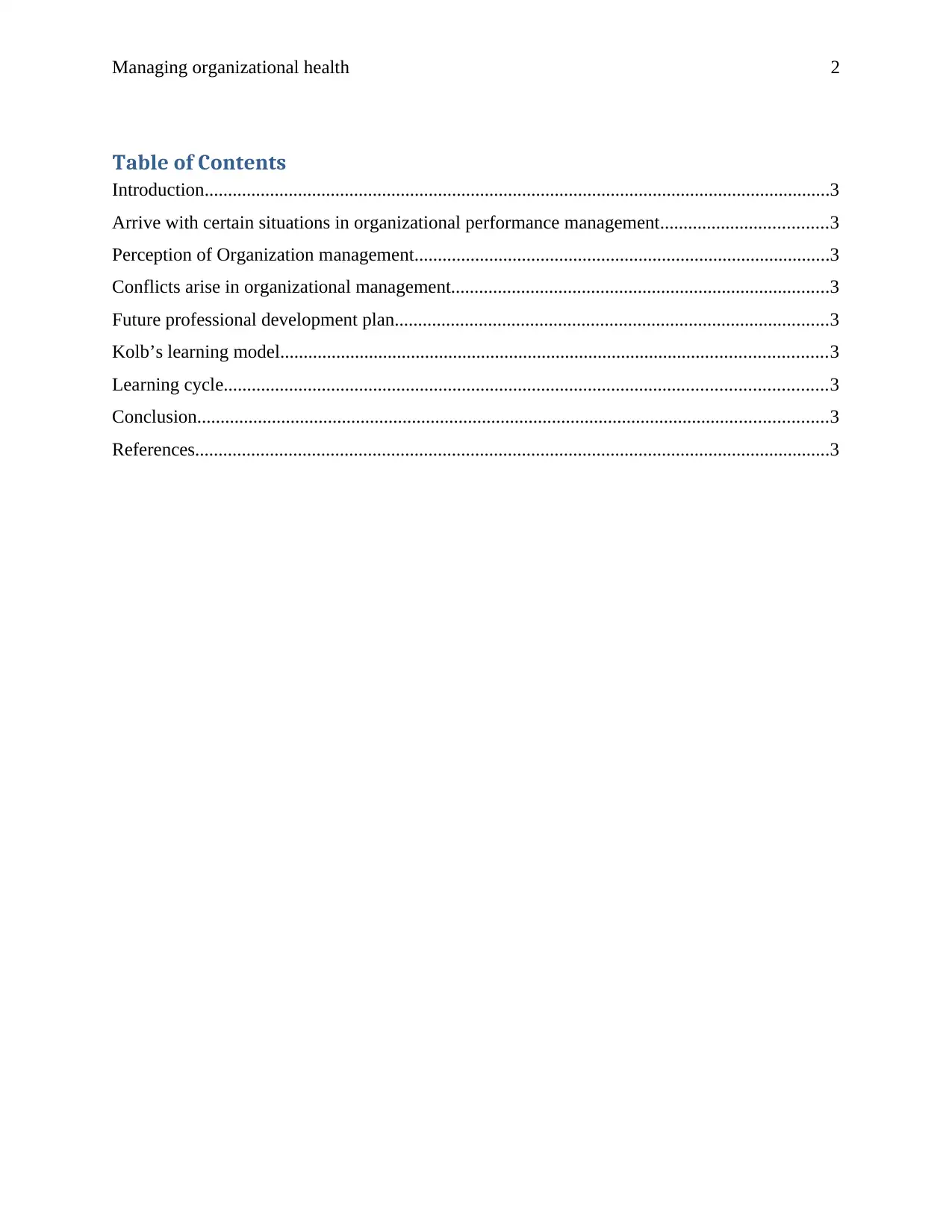
Managing organizational health 2
Table of Contents
Introduction......................................................................................................................................3
Arrive with certain situations in organizational performance management....................................3
Perception of Organization management.........................................................................................3
Conflicts arise in organizational management.................................................................................3
Future professional development plan.............................................................................................3
Kolb’s learning model.....................................................................................................................3
Learning cycle.................................................................................................................................3
Conclusion.......................................................................................................................................3
References........................................................................................................................................3
Table of Contents
Introduction......................................................................................................................................3
Arrive with certain situations in organizational performance management....................................3
Perception of Organization management.........................................................................................3
Conflicts arise in organizational management.................................................................................3
Future professional development plan.............................................................................................3
Kolb’s learning model.....................................................................................................................3
Learning cycle.................................................................................................................................3
Conclusion.......................................................................................................................................3
References........................................................................................................................................3
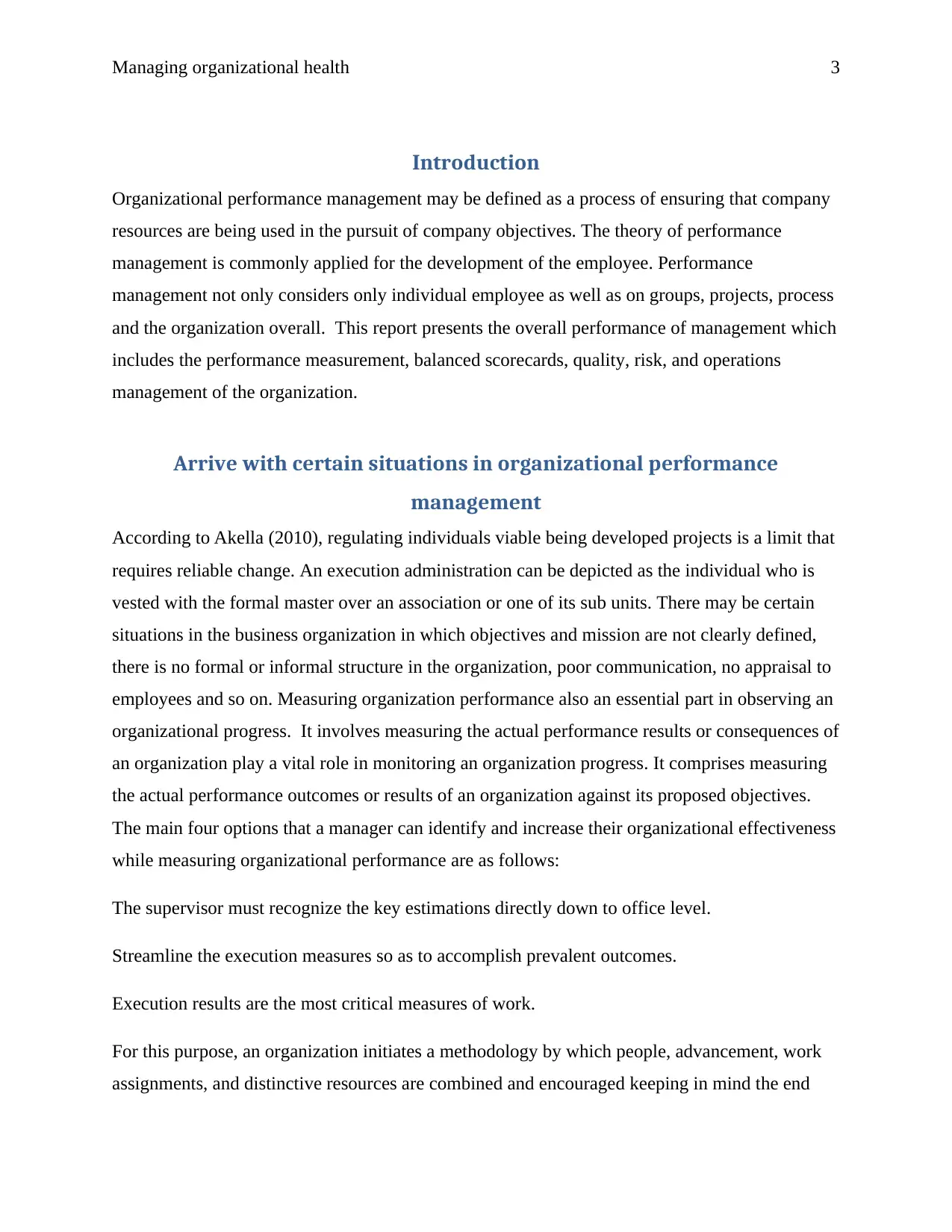
Managing organizational health 3
Introduction
Organizational performance management may be defined as a process of ensuring that company
resources are being used in the pursuit of company objectives. The theory of performance
management is commonly applied for the development of the employee. Performance
management not only considers only individual employee as well as on groups, projects, process
and the organization overall. This report presents the overall performance of management which
includes the performance measurement, balanced scorecards, quality, risk, and operations
management of the organization.
Arrive with certain situations in organizational performance
management
According to Akella (2010), regulating individuals viable being developed projects is a limit that
requires reliable change. An execution administration can be depicted as the individual who is
vested with the formal master over an association or one of its sub units. There may be certain
situations in the business organization in which objectives and mission are not clearly defined,
there is no formal or informal structure in the organization, poor communication, no appraisal to
employees and so on. Measuring organization performance also an essential part in observing an
organizational progress. It involves measuring the actual performance results or consequences of
an organization play a vital role in monitoring an organization progress. It comprises measuring
the actual performance outcomes or results of an organization against its proposed objectives.
The main four options that a manager can identify and increase their organizational effectiveness
while measuring organizational performance are as follows:
The supervisor must recognize the key estimations directly down to office level.
Streamline the execution measures so as to accomplish prevalent outcomes.
Execution results are the most critical measures of work.
For this purpose, an organization initiates a methodology by which people, advancement, work
assignments, and distinctive resources are combined and encouraged keeping in mind the end
Introduction
Organizational performance management may be defined as a process of ensuring that company
resources are being used in the pursuit of company objectives. The theory of performance
management is commonly applied for the development of the employee. Performance
management not only considers only individual employee as well as on groups, projects, process
and the organization overall. This report presents the overall performance of management which
includes the performance measurement, balanced scorecards, quality, risk, and operations
management of the organization.
Arrive with certain situations in organizational performance
management
According to Akella (2010), regulating individuals viable being developed projects is a limit that
requires reliable change. An execution administration can be depicted as the individual who is
vested with the formal master over an association or one of its sub units. There may be certain
situations in the business organization in which objectives and mission are not clearly defined,
there is no formal or informal structure in the organization, poor communication, no appraisal to
employees and so on. Measuring organization performance also an essential part in observing an
organizational progress. It involves measuring the actual performance results or consequences of
an organization play a vital role in monitoring an organization progress. It comprises measuring
the actual performance outcomes or results of an organization against its proposed objectives.
The main four options that a manager can identify and increase their organizational effectiveness
while measuring organizational performance are as follows:
The supervisor must recognize the key estimations directly down to office level.
Streamline the execution measures so as to accomplish prevalent outcomes.
Execution results are the most critical measures of work.
For this purpose, an organization initiates a methodology by which people, advancement, work
assignments, and distinctive resources are combined and encouraged keeping in mind the end
⊘ This is a preview!⊘
Do you want full access?
Subscribe today to unlock all pages.

Trusted by 1+ million students worldwide
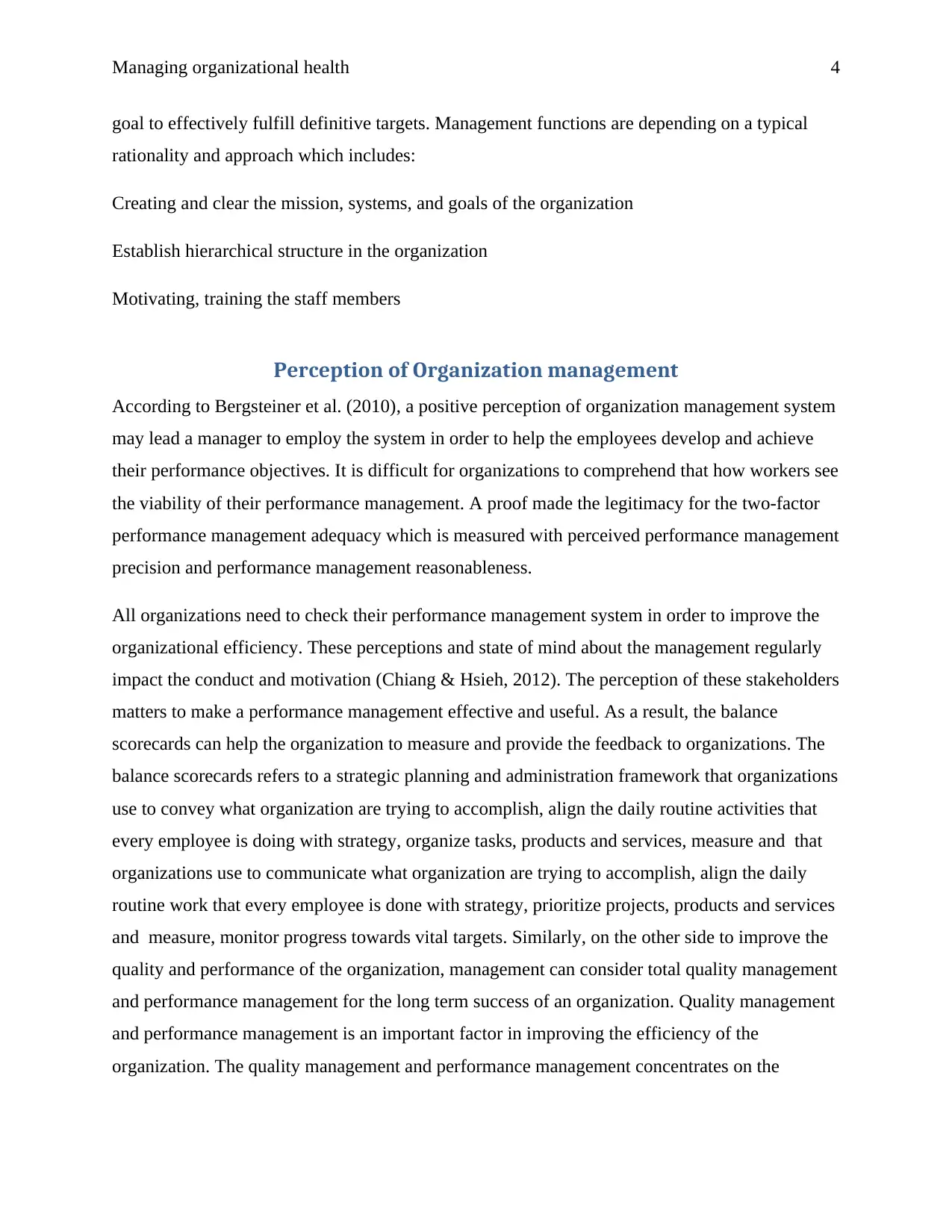
Managing organizational health 4
goal to effectively fulfill definitive targets. Management functions are depending on a typical
rationality and approach which includes:
Creating and clear the mission, systems, and goals of the organization
Establish hierarchical structure in the organization
Motivating, training the staff members
Perception of Organization management
According to Bergsteiner et al. (2010), a positive perception of organization management system
may lead a manager to employ the system in order to help the employees develop and achieve
their performance objectives. It is difficult for organizations to comprehend that how workers see
the viability of their performance management. A proof made the legitimacy for the two-factor
performance management adequacy which is measured with perceived performance management
precision and performance management reasonableness.
All organizations need to check their performance management system in order to improve the
organizational efficiency. These perceptions and state of mind about the management regularly
impact the conduct and motivation (Chiang & Hsieh, 2012). The perception of these stakeholders
matters to make a performance management effective and useful. As a result, the balance
scorecards can help the organization to measure and provide the feedback to organizations. The
balance scorecards refers to a strategic planning and administration framework that organizations
use to convey what organization are trying to accomplish, align the daily routine activities that
every employee is doing with strategy, organize tasks, products and services, measure and that
organizations use to communicate what organization are trying to accomplish, align the daily
routine work that every employee is done with strategy, prioritize projects, products and services
and measure, monitor progress towards vital targets. Similarly, on the other side to improve the
quality and performance of the organization, management can consider total quality management
and performance management for the long term success of an organization. Quality management
and performance management is an important factor in improving the efficiency of the
organization. The quality management and performance management concentrates on the
goal to effectively fulfill definitive targets. Management functions are depending on a typical
rationality and approach which includes:
Creating and clear the mission, systems, and goals of the organization
Establish hierarchical structure in the organization
Motivating, training the staff members
Perception of Organization management
According to Bergsteiner et al. (2010), a positive perception of organization management system
may lead a manager to employ the system in order to help the employees develop and achieve
their performance objectives. It is difficult for organizations to comprehend that how workers see
the viability of their performance management. A proof made the legitimacy for the two-factor
performance management adequacy which is measured with perceived performance management
precision and performance management reasonableness.
All organizations need to check their performance management system in order to improve the
organizational efficiency. These perceptions and state of mind about the management regularly
impact the conduct and motivation (Chiang & Hsieh, 2012). The perception of these stakeholders
matters to make a performance management effective and useful. As a result, the balance
scorecards can help the organization to measure and provide the feedback to organizations. The
balance scorecards refers to a strategic planning and administration framework that organizations
use to convey what organization are trying to accomplish, align the daily routine activities that
every employee is doing with strategy, organize tasks, products and services, measure and that
organizations use to communicate what organization are trying to accomplish, align the daily
routine work that every employee is done with strategy, prioritize projects, products and services
and measure, monitor progress towards vital targets. Similarly, on the other side to improve the
quality and performance of the organization, management can consider total quality management
and performance management for the long term success of an organization. Quality management
and performance management is an important factor in improving the efficiency of the
organization. The quality management and performance management concentrates on the
Paraphrase This Document
Need a fresh take? Get an instant paraphrase of this document with our AI Paraphraser

Managing organizational health 5
continuous procedure of improvement within organizations in order to provide the superior
customer value and meet the requirements of consumer demands.
Conflicts arise in organizational management
According to Easterby-Smith et al. (2011), organizations in the present situation are in an
unstable condition where affiliations are scanning for measures that will empower them to
upgrade their execution and force. Organizational clash is seen as the distinction that happens
when the objectives, interests or estimations of various people or get-togethers are clashing with
those of individuals or social affairs square or disappoint every other trying to accomplish their
goals. In any organization, there are many reasons for conflicts as clashes inside an individual
more often than not happen when a person is vague about what task to do, if not specifically
characterized by the manager or the individual in control. On the other hand, risk factors also
exist in the organization which affects the organizational performance. In order to manage the
risk in the organization, risk management is important in an organization because without the
risk management factor, a business cannot define its objectives. The risk management plays a
role to recognize group is to distinguish risks that come up with strategies to prevent against
these risks, to implement these strategies and to encourage all members of the organization to
participate in these strategies.
Future professional development plan
According to Elsbach (2014), a professional development plan design reports, objectives,
required expertise and competency advancement and objectives a staff member should fulfill so
as to help constant change and professional change and better advancement. An expert
advancement configuration is made by the administrator working by and by with the staff part to
recognize the central capacities to help the staff part's proficient destinations and the hierarchical
business needs. The supervisor can utilize the accompanying strides to influence an expert
advancement to design with the representative which are as follows:
Step 1: The manager can request a self-assessment from the other staff members of the
organization.
continuous procedure of improvement within organizations in order to provide the superior
customer value and meet the requirements of consumer demands.
Conflicts arise in organizational management
According to Easterby-Smith et al. (2011), organizations in the present situation are in an
unstable condition where affiliations are scanning for measures that will empower them to
upgrade their execution and force. Organizational clash is seen as the distinction that happens
when the objectives, interests or estimations of various people or get-togethers are clashing with
those of individuals or social affairs square or disappoint every other trying to accomplish their
goals. In any organization, there are many reasons for conflicts as clashes inside an individual
more often than not happen when a person is vague about what task to do, if not specifically
characterized by the manager or the individual in control. On the other hand, risk factors also
exist in the organization which affects the organizational performance. In order to manage the
risk in the organization, risk management is important in an organization because without the
risk management factor, a business cannot define its objectives. The risk management plays a
role to recognize group is to distinguish risks that come up with strategies to prevent against
these risks, to implement these strategies and to encourage all members of the organization to
participate in these strategies.
Future professional development plan
According to Elsbach (2014), a professional development plan design reports, objectives,
required expertise and competency advancement and objectives a staff member should fulfill so
as to help constant change and professional change and better advancement. An expert
advancement configuration is made by the administrator working by and by with the staff part to
recognize the central capacities to help the staff part's proficient destinations and the hierarchical
business needs. The supervisor can utilize the accompanying strides to influence an expert
advancement to design with the representative which are as follows:
Step 1: The manager can request a self-assessment from the other staff members of the
organization.
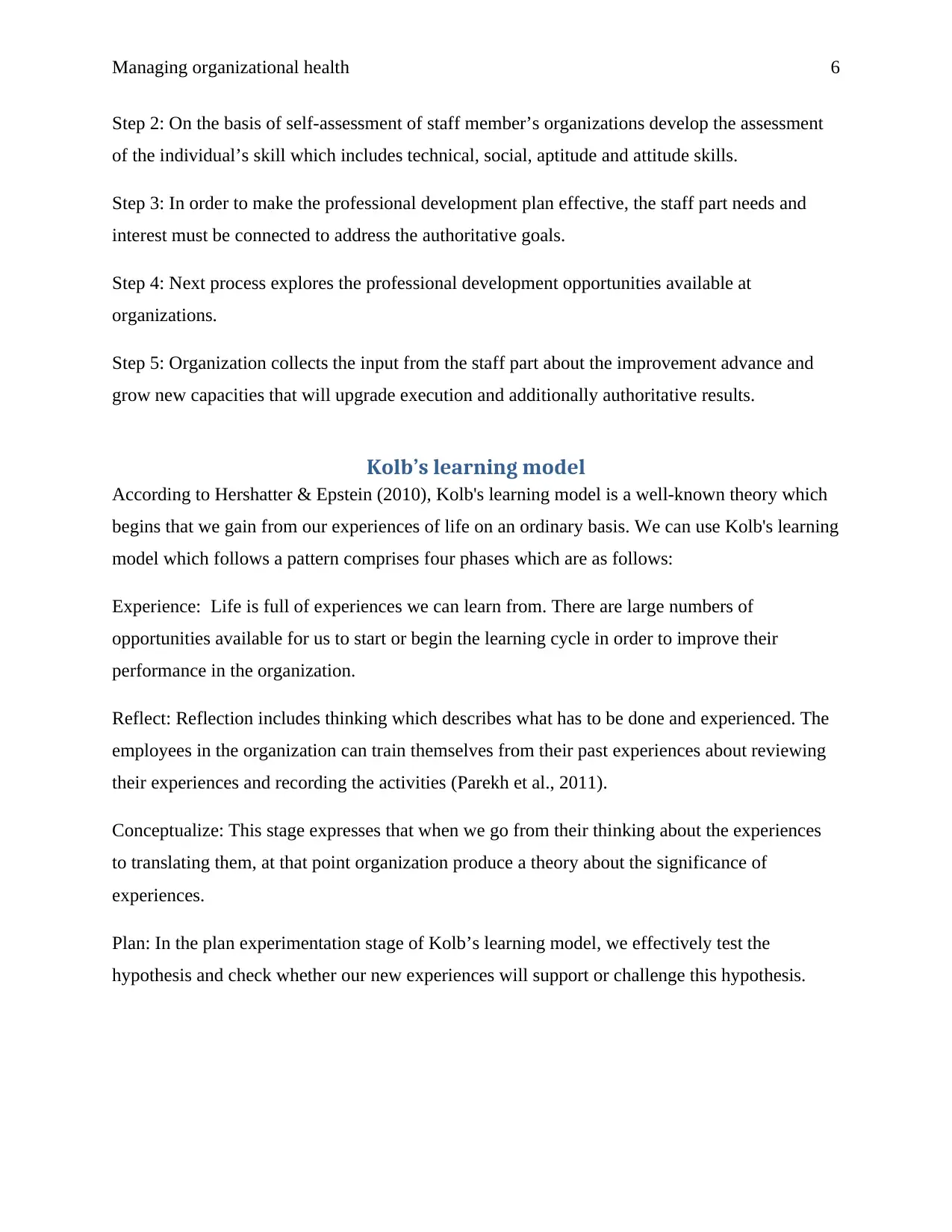
Managing organizational health 6
Step 2: On the basis of self-assessment of staff member’s organizations develop the assessment
of the individual’s skill which includes technical, social, aptitude and attitude skills.
Step 3: In order to make the professional development plan effective, the staff part needs and
interest must be connected to address the authoritative goals.
Step 4: Next process explores the professional development opportunities available at
organizations.
Step 5: Organization collects the input from the staff part about the improvement advance and
grow new capacities that will upgrade execution and additionally authoritative results.
Kolb’s learning model
According to Hershatter & Epstein (2010), Kolb's learning model is a well-known theory which
begins that we gain from our experiences of life on an ordinary basis. We can use Kolb's learning
model which follows a pattern comprises four phases which are as follows:
Experience: Life is full of experiences we can learn from. There are large numbers of
opportunities available for us to start or begin the learning cycle in order to improve their
performance in the organization.
Reflect: Reflection includes thinking which describes what has to be done and experienced. The
employees in the organization can train themselves from their past experiences about reviewing
their experiences and recording the activities (Parekh et al., 2011).
Conceptualize: This stage expresses that when we go from their thinking about the experiences
to translating them, at that point organization produce a theory about the significance of
experiences.
Plan: In the plan experimentation stage of Kolb’s learning model, we effectively test the
hypothesis and check whether our new experiences will support or challenge this hypothesis.
Step 2: On the basis of self-assessment of staff member’s organizations develop the assessment
of the individual’s skill which includes technical, social, aptitude and attitude skills.
Step 3: In order to make the professional development plan effective, the staff part needs and
interest must be connected to address the authoritative goals.
Step 4: Next process explores the professional development opportunities available at
organizations.
Step 5: Organization collects the input from the staff part about the improvement advance and
grow new capacities that will upgrade execution and additionally authoritative results.
Kolb’s learning model
According to Hershatter & Epstein (2010), Kolb's learning model is a well-known theory which
begins that we gain from our experiences of life on an ordinary basis. We can use Kolb's learning
model which follows a pattern comprises four phases which are as follows:
Experience: Life is full of experiences we can learn from. There are large numbers of
opportunities available for us to start or begin the learning cycle in order to improve their
performance in the organization.
Reflect: Reflection includes thinking which describes what has to be done and experienced. The
employees in the organization can train themselves from their past experiences about reviewing
their experiences and recording the activities (Parekh et al., 2011).
Conceptualize: This stage expresses that when we go from their thinking about the experiences
to translating them, at that point organization produce a theory about the significance of
experiences.
Plan: In the plan experimentation stage of Kolb’s learning model, we effectively test the
hypothesis and check whether our new experiences will support or challenge this hypothesis.
⊘ This is a preview!⊘
Do you want full access?
Subscribe today to unlock all pages.

Trusted by 1+ million students worldwide
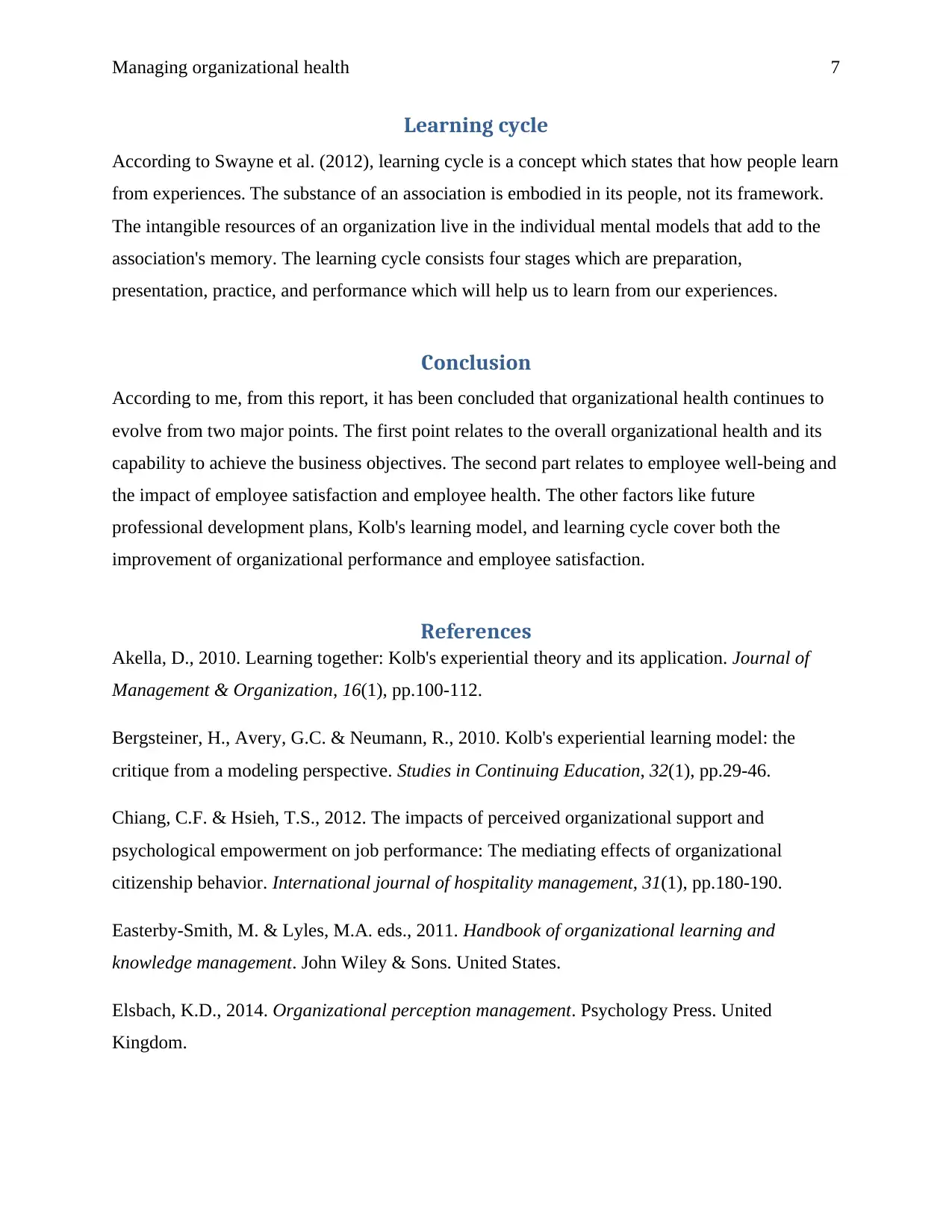
Managing organizational health 7
Learning cycle
According to Swayne et al. (2012), learning cycle is a concept which states that how people learn
from experiences. The substance of an association is embodied in its people, not its framework.
The intangible resources of an organization live in the individual mental models that add to the
association's memory. The learning cycle consists four stages which are preparation,
presentation, practice, and performance which will help us to learn from our experiences.
Conclusion
According to me, from this report, it has been concluded that organizational health continues to
evolve from two major points. The first point relates to the overall organizational health and its
capability to achieve the business objectives. The second part relates to employee well-being and
the impact of employee satisfaction and employee health. The other factors like future
professional development plans, Kolb's learning model, and learning cycle cover both the
improvement of organizational performance and employee satisfaction.
References
Akella, D., 2010. Learning together: Kolb's experiential theory and its application. Journal of
Management & Organization, 16(1), pp.100-112.
Bergsteiner, H., Avery, G.C. & Neumann, R., 2010. Kolb's experiential learning model: the
critique from a modeling perspective. Studies in Continuing Education, 32(1), pp.29-46.
Chiang, C.F. & Hsieh, T.S., 2012. The impacts of perceived organizational support and
psychological empowerment on job performance: The mediating effects of organizational
citizenship behavior. International journal of hospitality management, 31(1), pp.180-190.
Easterby-Smith, M. & Lyles, M.A. eds., 2011. Handbook of organizational learning and
knowledge management. John Wiley & Sons. United States.
Elsbach, K.D., 2014. Organizational perception management. Psychology Press. United
Kingdom.
Learning cycle
According to Swayne et al. (2012), learning cycle is a concept which states that how people learn
from experiences. The substance of an association is embodied in its people, not its framework.
The intangible resources of an organization live in the individual mental models that add to the
association's memory. The learning cycle consists four stages which are preparation,
presentation, practice, and performance which will help us to learn from our experiences.
Conclusion
According to me, from this report, it has been concluded that organizational health continues to
evolve from two major points. The first point relates to the overall organizational health and its
capability to achieve the business objectives. The second part relates to employee well-being and
the impact of employee satisfaction and employee health. The other factors like future
professional development plans, Kolb's learning model, and learning cycle cover both the
improvement of organizational performance and employee satisfaction.
References
Akella, D., 2010. Learning together: Kolb's experiential theory and its application. Journal of
Management & Organization, 16(1), pp.100-112.
Bergsteiner, H., Avery, G.C. & Neumann, R., 2010. Kolb's experiential learning model: the
critique from a modeling perspective. Studies in Continuing Education, 32(1), pp.29-46.
Chiang, C.F. & Hsieh, T.S., 2012. The impacts of perceived organizational support and
psychological empowerment on job performance: The mediating effects of organizational
citizenship behavior. International journal of hospitality management, 31(1), pp.180-190.
Easterby-Smith, M. & Lyles, M.A. eds., 2011. Handbook of organizational learning and
knowledge management. John Wiley & Sons. United States.
Elsbach, K.D., 2014. Organizational perception management. Psychology Press. United
Kingdom.
Paraphrase This Document
Need a fresh take? Get an instant paraphrase of this document with our AI Paraphraser
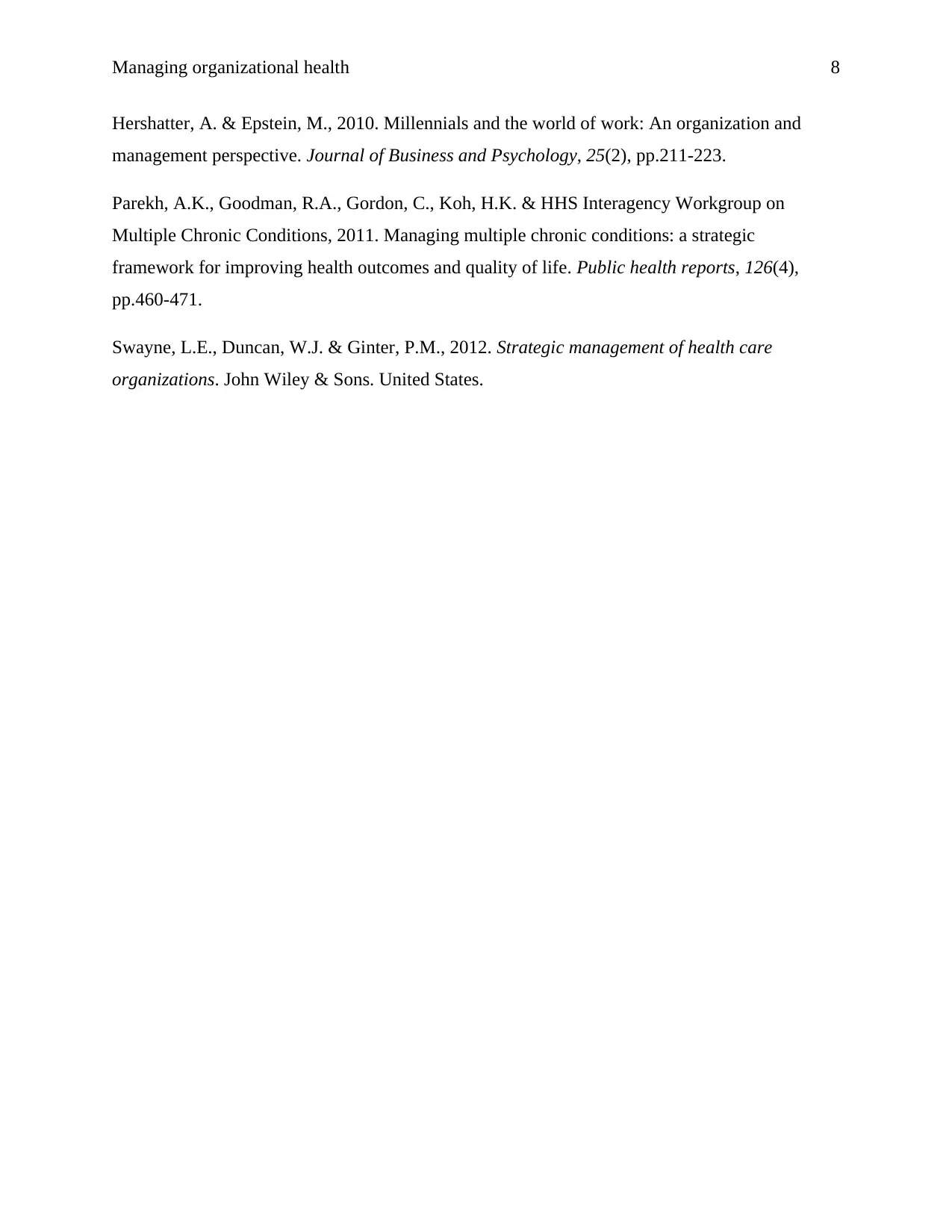
Managing organizational health 8
Hershatter, A. & Epstein, M., 2010. Millennials and the world of work: An organization and
management perspective. Journal of Business and Psychology, 25(2), pp.211-223.
Parekh, A.K., Goodman, R.A., Gordon, C., Koh, H.K. & HHS Interagency Workgroup on
Multiple Chronic Conditions, 2011. Managing multiple chronic conditions: a strategic
framework for improving health outcomes and quality of life. Public health reports, 126(4),
pp.460-471.
Swayne, L.E., Duncan, W.J. & Ginter, P.M., 2012. Strategic management of health care
organizations. John Wiley & Sons. United States.
Hershatter, A. & Epstein, M., 2010. Millennials and the world of work: An organization and
management perspective. Journal of Business and Psychology, 25(2), pp.211-223.
Parekh, A.K., Goodman, R.A., Gordon, C., Koh, H.K. & HHS Interagency Workgroup on
Multiple Chronic Conditions, 2011. Managing multiple chronic conditions: a strategic
framework for improving health outcomes and quality of life. Public health reports, 126(4),
pp.460-471.
Swayne, L.E., Duncan, W.J. & Ginter, P.M., 2012. Strategic management of health care
organizations. John Wiley & Sons. United States.
1 out of 8
Related Documents
Your All-in-One AI-Powered Toolkit for Academic Success.
+13062052269
info@desklib.com
Available 24*7 on WhatsApp / Email
![[object Object]](/_next/static/media/star-bottom.7253800d.svg)
Unlock your academic potential
Copyright © 2020–2025 A2Z Services. All Rights Reserved. Developed and managed by ZUCOL.





